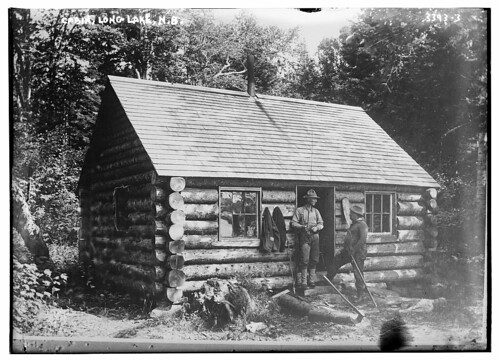Log Cabins: Two Ways
I always learn something new when My Own True Love and I head out on a Road Trip Through History. Our recent expedition to Colonial Michilimacinac was no exception.
- I learned that eighteenth century cooks dried pumpkins as well as apples* and used pig bladders to seal crocks of prickled vegetables.
- I had long known that when push came to shove (so to speak) the bayonet was a more useful weapon than the musket to which it was affixed. I had not previously known that with repeated firing the sides of the bayonet became coated with a greasy toxin that meant soldiers stabbed with a bayonet were unlikely to survive even a flesh wound. **
- I was introduced to wall guns–a weapon that combined the blasting power of a cannon with the mobility of a musket. Obviously a besieged fort’s best friend.
But the thing that struck me the most forcibly was the difference between how the British and the French built log cabins in the wilderness.
The Anglo-American log cabin style is what I picture when I think of log cabins: horizontal logs fitted together with notches and chinked with mud.
photograph courtesy of the Library of Congress
It is the form that evolved into WPA lodges, resort cabins, and Lincoln Logs.***
The French Canadian style of construction, known as poteaux en terre, or posts in the ground, used vertical timbers set into trenches, then weather-proofed with chinking and plaster.
It’s a small difference, I know. But it somehow seemed emblematic of the larger differences of culture that exploded into violence along the borders of the British and French colonies–a subject I’ll be coming back to in later posts.
*I may have learned about dried pumpkin before and simply blocked it out. I know it’s un-American, but I do not like pumpkin and cannot understand wanting to preserve it for future use.
**I’m not sure why this came as a surprise. Until the commercial production of penicillin in WWII, infected wounds were a major cause of death in warfare.
***Invented by John Lloyd Wright, the son of architect Frank Lloyd Wright. Really. I was as surprised as you are.







Recently bought the Knivckerbocker Mansion and am looking for the largest vertical log cabin in America…..any thought where I might look?
You’ve got me stumped. And now I’m curious. Any ideas, Marginites?
If I remember, the “American” log cabin was brought here by the Scandinavians. Also, the advantage of using vertical logs was that you could get by with shorter (and thus easier to move) logs, a big plus if you were working alone in the wilderness.
Interesting point. Thanks.
Hello, I too am looking for information on “Vertical Log Cabins” I am aware of one in Virginia, in the area of Mathews County. My family has been fortunate to lease such a cabin and we run an antiques & collectibles business there.
We have done some research and have found information such as the approximate time it was built, 1913 as far as we have found but don’t know for sure. The Mathews County area of Virginia is rich with history and goes back well into the 1600’s.
I don’t know if this building is the largest as you mentioned you are looking for but it is a good size. It consists of the Main Room(front room) 2 rooms off to the side of the front room, 2 rooms off to the back of the front room and sometime during time a bathroom was added which consist of an old claw foot tub. There was at one time a septic system installed but has not been used in years. We have a service that supplies port-o-potty…..
We have been fortunate to have people from our community stop by with stories of the history and former uses of the “Old Log Cabin on Rt. 14” since last being used as a private dwelling. From what we have found it was originally what was known in the area as “The Noble Farm” and it is believed to have been used for the farm workers housing.
I intend to spend some time at our library to see what else I can find out about the cabin.
I hope this may help in your research and if you are interested in additional info. feel free to contact me and I will share whatever I may find or with the information I have provided here you may be able to find more information.
The area of Virginia I have mentioned is located on the Chesapeake Bay, not far from Yorktown, Va. , as I mentioned the whole area is rich in history….
Take care and hope you find the info you are looking for.
Cindy
For pictures of the cabin you can find some on facebook by searching Mermaids Crossing
Is there a difference in the construction of a log cabin and a log house?
My guess is size and complexity. But I don’t really know